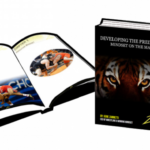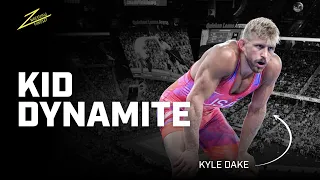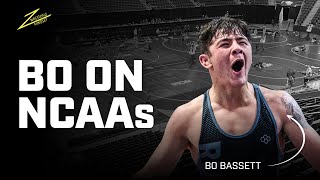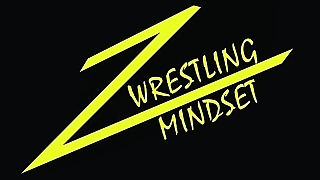Learn
Developing the predator mindset: intro to ebook
Dear Wrestler,
Most serious wrestlers would agree that wrestling is one of the most mental sports in the world. How often have we all had the technical skills and physical prowess to win, yet still came up short because our mindset was not where it needed to be the day of competition? Not only have I seen this over the past ten years as a mindset coach, but I have also lived it, as a former nationally ranked, All-Ivy League wrestler.
Some of the most common mindset struggles we have seen with wrestlers include not pulling the trigger or wrestling aggressively, choking in big matches, different wrestler in practice and a match, being a slow starter, giving good opponents too much respect, performing better in practice than competition, too cautious/hesitant, and difficulty bouncing back after a loss. This is exactly why Wrestling Mindset and this book were created! Wrestling Mindset is a wrestling specific, systematic program made by wrestlers for wrestlers.
This book has two parts. Part one is dedicated to explaining the Predator Mindset versus Prey Mindset and why that is the difference between success and failure in sports, school, and life. It is a simple analogy that permeates all areas of life. Along with the Predator Mindset, you will also learn how to develop a competition “Alter Ego” which has been one of our most unique and successful lessons.
Part 2 of this book is designed to share some of our best mindset exercises that have been used with thousands of athletes across the country. The key there is to actually DO THE EXERCISES. There are many books that talk about what confidence is and why it is important. This book will make you more confident if you do what it says to do.
was a collegiate wrestler and coach. With my background in Psychology, I created Wrestling Mindset which has become the top wrestling specific mindset program in the world working with all athletes from youth through the Olympic teams. Please enjoy learning and most importantly, applying Wrestling Mindset! God bless you.
BUY THE FULL EBOOK HERE OR KEEP READING MORE OF THE SAMPLE BELOW
PREDATOR MINDSET
The ultimate guide to success in Sports, School, Business, & Life
Deep in the African savanna, a lion patiently watches a gazelle. The lion crouches in the tall grass and stalks ahead, gazing intently at its prey. The gazelle hears a faint rustling and looks up. Its eyes dart from left to right, scanning the horizon for imminent dangers. But it sees none and resumes feeding. The lion springs into action with an explosion of effortless speed and power. By the time the gazelle notices, it’s too late. The lion has triumphed once again in this primal fight for survival.
Predator and prey. The animal kingdom can be broken down into these two kinds of animals. Eat or be eaten. It’s not pretty, but it’s the way of the animal kingdom. There is a simple way to tell if a mammal is a predator or prey just by looking at them. Is it their teeth? No. Their claws? No. Their size? No. It’s their eyes.
If you look at predator animals, like lions, tigers, and bears, you will notice that their eyes are located squarely on the front of their head. Why might they have evolved to have eyes on the front of their head? Survival. With eyes on the front, the predator is laser focused on its goal: lunch!
On the other hand, prey animals, like squirrels, chipmunks, and rabbits, have eyes on the side of their head. Why might prey have evolved to have eyes on the side of their head? Again, survival. To live, the prey animal must be on the lookout for what is going on around them or they will get eaten!
I studied animal behavior as an undergraduate in the psychology program at the University of Pennsylvania, where I was an elite college wrestler. At the time, the full impact of studying animals’ adaptations hadn’t yet dawned on me. And I certainly never would have thought that 10 years later I would be at the U.S. Olympic Training Center, presenting this lesson to some of the top athletes in the world!
As a mindset coach, I have worked with tens of thousands of athletes around the country, from young children to Olympians. I have helped them succeed not only in competition, but in every area of their life, from school to personal relationships.
The Predator Mindset: Effort, Attitude, and Aggressiveness, has proven to be the most effective tool in training these athletes. It is the backbone of my winning mindset system, which has become the top sport specific mindset program in the country. The predator mindset can be stated simply: “Eyes on the front like to hunt, eyes on the side like to hide!”
Predator athletes, with eyes on the front of their head, are focused on nothing but their goals. They focus on the factors within their control. They look forward. They live for the hunt. They go for the kill.
BUY THE EBOOK HERE
Prey athletes, with eyes on the side of their head, focus on things going on around them. They obsess over factors outside of their control. They follow the rankings. They focus on social media. They worry about what their parents, coaches, and friends think about them.
These timeless principles go well beyond athletics. They apply to business, sales, or even weight loss. In this book, I will train you to maneuver with the ferocious hunger of a lion, rather than the cautious appetite of a gazelle.
Step one is simple. It begins with a consistent morning routine. After you wake up and wash your face and brush your teeth, look at yourself in the mirror and locate your eyes. Are they on the front or the side? I once posed this question to a large group of child and teenage athletes. An eight-year-old literally jumped to his feet in excitement. “I can’t believe it, I’m a predator!” After running over to give this enthusiastic kid a highfive, I kindly reminded the audience, “That’s exactly how fired up all of you should be feeling!”
Regardless of our external excitement, we must understand this fact: we are all born predators! In this book, I will teach you how to distinguish the patterns of predator and prey thinking, and how to use those patterns to reach your goals. The Predator Mindset will show you how to achieve success in every area of your life.
Eye of the tiger!
To understand how the Predator Mindset is the answer to achieving our goals, we must first examine the role that our mindset plays in our success.
PURCHASE EBOOK HERE
What percentage of sports is physical and what percentage is mental? This is an interesting question. Experience has shown me that I can ask any sports team, of any age, and the answer will be anywhere from 50-90% mental. It is hard to imagine such a uniform answer among athletes of such different sports and ages. My next question is where things really become interesting. What percentage of your time are you training physically versus mentally? Crickets! Most say 95% of their time is spent on physical training. We can instantly see the problem. We must train smarter. It is easy to see how those percentage numbers don’t jive. If you are saying sports are at least 50% mental, then it stands to reason you must spend 50% of your time training your mind. Now, not for one second should you think this downplays the importance of physical training. As a personal trainer and sports nutritionist with a Master’s Degree in Exercise Science I cannot overexpress how vital it is to maintain a balance between physical and mental training.
Ok, so we know our success depends on our mindset. Most coaches and leaders understand this. So why isn’t more being done to train this area?
I CAN GIVE THREE REASONS:
1. Coaches don’t exactly know how to train their athletes’ mindsets
2. Current psychological strategies are too boring or ineffective
3. It is too embarrassing or shameful to admit our weaknesses
Let’s look at each of these.
1. Often, coaches don’t know exactly how to train their athletes’ mindsets. This is not their fault. Most are never trained on how it’s done. I once heard that there are no such things as skilled or unskilled, only trained and untrained. Most are untrained. You won’t be by the end of this book. Not knowing how to train mindset results in (a) leaving it to chance (b) circular reasoning (c) well intentioned, weak attempts.
Leaving it to chance. Technique, strength, and nutrition are far easier to see. Things that are easier to see seem to be easier to coach. Therefore, many coaches neglect this area completely, outside of maybe some pep talks, team huddles, and yelling here and there.
Circular Reasoning When I was competing, coaches would say I needed to be confident. Okay, great, how do I do that? They would tell me to just believe in myself. Okay, well how do I do that? They would tell me to be confident. Circular reasoning never solved anything. The same thing happened when I would try to overcome nerves and anxiety before competition. Coaches would say to keep calm. Well how do I keep calm? They would tell me to just relax. Okay, how do I relax? By now, you see the pattern. Just keep calm. And the wheels on the bus go round and round. Nothing is solved and now I am beating myself up for not knowing how to fulfill my coaches’ instructions. I made these same mistakes as a coach.
Weak Attempts I speak to many coaches who tell me they are doing the mindset training with the team themselves. Then when I ask what exactly the coach is doing with the team, I hear very predictable answers: I have them write down their goals, I usually talk to them before or after every practice, or I have them visualize success. I agree that this is an excellent start. But this is not what we mean by mindset training. It would be very similar if the team coach told you he or she was doing strength training by doing some pushups and pullups at the end of practice. Again, a great start, but unscientific and definitely not systematic.
2. Current psychological strategies in sports are boring and/or ineffective.
I’ve seen too many “mindset experts” turn wine into water with athletes in five ways (a) confusing mindset training with motivational speaking (b) using language that is too theoretical/psychological in their approach (c) starting with material that doesn’t elicit buy-in from the team (d) employing a damage control approach to mindset training (e) relying on a relativistic approach to mindset training.
GET EBOOK NOW
Confusing Mindset Training with Motivational Speaking As a School Psychologist, I saw firsthand the research on learning retention rates:
Many coaches will bring in a guest speaker to address their team; this is what these coaches consider “mindset training.” It’s a great start, but there is no training here other than listening. And listening to a lecture leads to an average of 5% retention. This is especially true with kids; it’s ‘in one ear and out the other.’ Imagine a practice session where the coach just dictated technique as the team sat and listened. How would you expect the athlete to perform this technique in competition without active practice? Instead of passive listening, we want to rely on active teaching methods –practical exercises.
To Purchase the Ebook: Developing the Predator Mindset, Click Here
‹ Back










